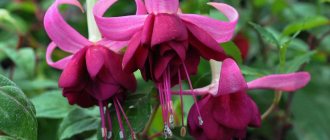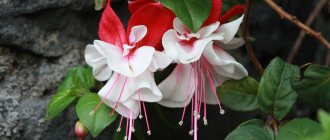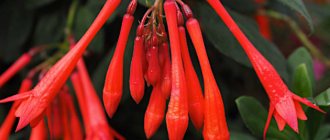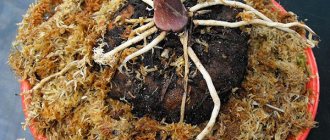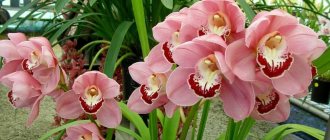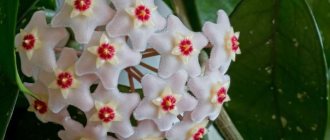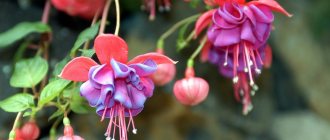Author: Elena N. https://floristics.info/ru/index.php?option=com_contact&view=contact&id=19 Category: Houseplants Published: June 11, 2012Republished: February 10, 2019Last edits: March 16, 2021
- Fuchsia fulgens
Botanical description
Fuchsia (lat. Fuchsia) is a plant belonging to the fireweed family and numbering up to 100 species. The plant was named after the German botanist Fuchs. Under natural conditions, it is widespread in South and Central America. Fuchsia, depending on the variety, is trees or small shrubs. In some species the leaves grow oppositely, in others - in whorls; Some types of fuchsia shed their leaves after the end of the growing season. The leaves are lanceolate, elongated oval or ovoid; The edges of the leaves can be either whole or with small serrations. Flower calyxes are tubular and elongated, most often white or red with long stamens. Even an amateur gardener can grow fuchsia - the plant is quite easy to care for. They are grown both as hanging plants and standard trees. One of the important conditions for caring for fuchsia is that the plant should overwinter in cool conditions. Another difficulty is that the plant sheds its leaves after flowering.
When can I transplant it outside?
When the rhizome develops and grows throughout the pot, the fuchsia is planted outdoors . By that time, the flower should have several shoots with leaves. Fuchsias love morning sun, so it is best to plant them on the east side. Although there are varieties that need shade in the afternoon.
Fuchsia is planted in a hole half filled with compost. It is good to do this by transshipment, that is, the plant is taken from the pot along with the soil. The walls of the hole are also filled with compost. Find out how to grow fuchsia, including in the garden, here.
Briefly about cultivation
- Flowering: from spring to late autumn.
- Lighting: bright diffused light.
- Temperature: during the growing season – 18-24 ºC, in winter – 5-10 ºC.
- Watering: from March to September - immediately after the top layer of soil has dried, and from the end of November - only occasionally, not allowing the earthen ball to dry out completely.
- Air humidity: from May to August, spraying with warm water is needed early in the morning and in the evening, and in the fall - once every 2-3 days. In winter, spraying is stopped.
- Feeding: from April to September - every two weeks with complex mineral fertilizer for flowering plants.
- Dormant period: from late October to late January.
- Trimming: at the beginning of the active. Shoots of ampelous fuchsia varieties are not pruned.
- Transplantation: annually in early March, after pruning.
- Substrate: 3 parts leaf soil, 2 parts peat and 1 part sand.
- Reproduction: seeds and cuttings.
- Pests: whiteflies and spider mites.
- Diseases: spotting, rot, loss of decorativeness due to violation of maintenance conditions or improper care.
Read more about growing fuchsia below.
Ampel varieties
The uniqueness of this type is that the long branches fall down freely. You can decorate the veranda with these flowers by placing them in flower pots. For volumetric flowering, 2-3 cuttings are planted in one container.
If you graft an ampelous fuchsia onto a bush stamp, you can get a beautiful tree with flowing branches. Canopy varieties prefer partial shade and do not tolerate drafts.
Golden Marinka
Variegated type of ampelous character.
Flowering is lush and long. The shoots are of medium length, weakly branched, and hang neatly. The flowers are medium-sized, simple or semi-double. The color is bright scarlet. An additional decorative effect is created by the yellow tint of green leaves. To make the plant look beautiful, pinch the branches. The stems are strong, but do not become woody. Roots poorly from cuttings. Does not like excess moisture.
First love
The variety is distinguished by strong branching and rapid growth. The flowers are large. The leaves are oval, slightly elongated, green. White cups with a slight pink splash, the skirt is a soft lilac color.
Representatives of this variety are difficult to propagate at home, as cuttings do not take root well.
Isisl (icicle)
A beautiful, vigorous bush with reddish shoots. They lignify slightly. The leaves are bright, rich green, with visible red-brown veins. The inflorescences are large with cream sepals and a delicate pink skirt.
Does not like bright scorching sun. Under direct rays it quickly gets burned. It is difficult to root the petioles.
Caring for fuchsia at home
Lighting
The optimal location of the fuchsia plant is considered to be windows on the eastern and western windows, since the plant needs a lot of bright, but diffused light. Can tolerate direct sunlight in the morning and evening. If fuchsia is placed on a south-facing window at home, then the plant must be covered with a translucent cloth or paper to avoid burns. On the north side, lack of lighting can lead to stretching of the plant and poor flowering (or lack thereof). When indoor fuchsia blooms, it should not be rearranged or rotated, as this may cause the plant to shed its buds and leaves. Fuchsia can be taken outside in the summer, but this must be done gradually, accustoming it to new conditions.
Temperature
Air temperature during the growing season can range from 18 to 24 °C. Fuchsia should overwinter in a cool place (5 to 10 °C above zero) with good lighting. At higher temperatures, fuchsia sheds its leaves and the shoots elongate. The plant needs an influx of fresh air, but it must be ventilated carefully, since drafts can destroy the plant. In summer, the plant can be placed on the balcony, providing suitable conditions - absence of precipitation, draft and direct sunlight.
Watering fuchsia
Water homemade fuchsia with soft, settled water at room temperature. From March to September, water immediately after the top layer of soil has dried, since at this time the substrate should be constantly slightly moist. From October, the frequency of watering is reduced, and by the end of November it almost stops (this will contribute to more abundant flowering next year). When keeping fuchsia in winter at temperatures up to 10 °C, it is watered very rarely, and when wintering above 10 °C - a little more often.
- Caladium: care and reproduction
Spraying
Spray the fuchsia flower with soft water - you need to let the water sit for 24 hours before spraying. From May to August, spray twice a day - before 9 am and after 6 pm. In autumn, spray once every two to three days. There is no need to spray the plant in winter.
Top dressing
From April to September, the fuchsia plant is fed every 2-3 weeks with complex mineral fertilizers for indoor plants. In winter, the plant does not need feeding.
Bloom
Compliance with all the conditions for keeping fuchsia indoors will give it the opportunity to bloom from May to November, and even produce berry-like juicy fruits. Withered flowers must be removed - this helps the plant form young buds. Moving fuchsia to the balcony in July and pruning it three times over the summer will promote long-term flowering - right up to December.
Trimming
Overwintering fuchsia at room temperature causes the stems to stretch and the leaves to fall off. Since flowers are formed mainly on young shoots, in order to promote their development, old bare shoots need to be pruned (they can be used for propagation by cuttings). Throughout the growing season, indoor fuchsia flowers are cut and pinched. Pinch out young shoots after three pairs of leaves have formed.
To form a tree, one vertically growing shoot is attached to a vertical support and all side shoots are pruned until the trunk reaches the desired height. After this, the top is cut off and 3-5 side shoots are allowed to develop, which will form the crown of the tree. In three years, a beautiful lush crown will form.
Fuchsia transplant
Indoor fuchsia is transplanted annually in early March. Before transplanting, cut off old shoots by at least a third and slightly shorten the roots. In ampelous species, the shoots are not shortened, since the plant loses its decorative effect. Replant fuchsia in slightly acidic soil consisting of deciduous soil, peat and sand (3: 2: 1). Another substrate option is 3 parts of clay-turf soil, 2 parts of greenhouse soil and 1 part. sand (and some peat chips). Drainage is poured into the bottom of the pot to one-fifth of its height. After transplantation, the plant is generously sprayed and watered, and placed in a place with bright, diffused light. In mid-summer, home fuchsia can be replanted in fresh soil.
- Photo of Gloriosa magnificent
Growing from seeds
To obtain fuchsia seeds, you need to artificially pollinate. By pollinating different types of fuchsias with different shapes and shades of flowers, you can get a new hybrid.
Propagation by cuttings
When propagating by cuttings, cuttings 5-7 cm in length are needed. To root, fuchsia cuttings are placed in water or one end is buried in sand. The cuttings will take root within 3-4 weeks. The cuttings are planted in 9-centimeter individual pots in a substrate of equal parts of humus, leaf and turf soil, and sand. To grow lush bushes, cuttings need to be planted several in one pot. Young domestic fuchsias should bloom in the same year. Species that grow slowly are best propagated by cuttings in late summer.
Reproduction methods
Fuchsia can be propagated in the following ways:
- cuttings;
- leaves;
- seeds.
The easiest way to propagate fuchsia is by cuttings
Most often, flower growers resort to cuttings, which are carried out in the spring. Step-by-step instructions for propagating fuchsia by cuttings:
- Cut several 15-centimeter cuttings from the mother plant (it is advisable to do this in early autumn).
- Remove the lower leaves from the shoots.
- Pack the cuttings in a bag of sawdust and place them on the bottom shelf of the refrigerator.
- With the onset of spring, remove the shoots from the refrigerator and treat them with a manganese solution.
- Place the cuttings in jars with filtered water.
- Cover them with polyethylene on top.
- Transplant the cuttings after 2 weeks into prepared pots with drainage and soil mixture.
If it is not possible to cut cuttings suitable for propagation from fuchsia, then the plant can be propagated by leaves. In this case, the procedure should be carried out as follows:
- Cut off a large leaf along with the cuttings.
- Bury the sheet 1 cm into moistened perlite.
- Cover the container with polyethylene.
- Carry out daily spraying.
- Separate the resulting rosette of leaves from the leaf as soon as it is strong enough.
- Plant the rosette in a separate container with soil mixture.
Propagation by seeds is carried out extremely rarely, since this method is complex and time-consuming.
Video: cuttings
Diseases and pests
Fuchsia is sick. Fuchsias do not tolerate stagnant air well - during the growing season the room must be regularly ventilated or the fuchsia must be placed on the balcony.
Fuchsia fades quickly. Fuchsia can bloom for a short period with abundant watering and keeping in warm conditions in winter; in case of insufficient lighting in spring and summer; with insufficient watering and fertilizing in summer.
Fuchsia leaves are falling off. If fuchsia sheds its leaves in winter, the plant can be removed from bright light, and the emerging buds must be pinched.
Fuchsia is shedding its leaves. Leaves may fall off if humidity is too low, watering is poor, and temperatures are too high.
Fuchsia buds fall off when there is insufficient light and too warm air, as well as when watering is irregular.
- Smithiantha - care, photos, types
Spots on fuchsia leaves. The plant may develop spotting if the plant is watered too often in winter.
Fuchsia has dropped its buds. During flowering or the appearance of buds, the plant cannot be moved - it may drop the buds. The same consequences will occur if fuchsia is placed in a draft.
Fuchsia pests. Most often, fuchsias are bothered by whiteflies and spider mites.
Spring pruning
As already noted, in winter fuchsias should be kept at lower temperatures. Then there is less chance that the plant will begin to grow prematurely. In the spring, to stimulate the growth of strong, healthy shoots, pruning is carried out. All weak and damaged shoots are cut out, old stems are shortened by a couple of buds. Since fuchsia blooms on the current year's shoots, there is no need to worry that you will not see flowers if you prune the plant too much. Moreover, if fuchsia is not pruned in the spring, it will form a thick, unkempt crown. Such a specimen will bloom sluggishly and contributes to long and abundant flowering throughout the season.
Kinds
Fuchsia fulgens
Found naturally in the Mexican mountains. These are one to two meter evergreen shrubs with bare branched shoots. The leaves are large, elongated egg-shaped or heart-shaped; they reach 20 cm in length and 12 cm in width, not pubescent, serrated along the edge. Reddish flowers grow in pendulous racemes at the top of the shoots; the corolla tube tapers towards the base and reaches a length of up to 10 cm; petals are up to 10 cm long. The fruit is an edible berry. The flowering period is all summer.
Bolivian Fuchsia / Fuchsia boliviana
It lives in the mountainous regions of Argentina, Ecuador and Bolivia. Evergreen shrubs growing in height up to a little over 1 m. The leaves are pointed at the apex, ovoid or elliptical in shape with small jagged edges, reach 15 cm in length and 6 cm in width. It blooms in early to mid-spring with dark red 1-cm flowers collected in apical racemes.
Fuchsia Magellanica / Fuchsia magellanica
Also known as Fuchsia discolor or Fuchsia conica. Shrubs growing in height from 2 to 5 m. The shoots are slightly pubescent, purple in color. The leaves grow either in whorls of 3 or alternately, reach a length of up to 5 cm, are ovate-lanceolate, serrated at the edges, covered with purple veins. The flowers are axillary and grow either singly or in groups of 4. The corolla tube is reddish, and the petals are bluish-purple. The flowering period is from late spring to late summer.
Fuchsia corymbiflora
It lives on mountain slopes in Ecuador and Peru. Shrubs with straight stems grow up to 5 m in height. Leaves are up to 17 cm long and up to 7 cm wide, oval in shape, slightly pubescent, smooth edge, red central vein. The calyx tube is red, the petals are purple. Flowering period is July-August.
How to replant?
The annual replanting of fuchsia is carried out in the spring. First, a drainage layer is created (expanded clay can be used). A little soil mixture (leaf soil, humus, peat) is poured onto the drainage. Carefully transfer the flower with a lump of earth to the prepared place. The remaining earthen mixture fills the voids in the pot.
The transplanted plant is placed indoors or on a window with sufficient light, watered well, sprayed and the shoots are cut by a third.
We recommend watching a video about replanting and pruning fuchsia:
Landing Features
Indoor and garden fuchsias, which are used in various landscape design options, are easy to breed, however, in order for them to grow well, the correct technology must be followed. Plants cannot be planted in large pots at once. The size of the containers is increased gradually as the root system grows and develops.
If you propagate fuchsia from cuttings, then pots with a diameter of nine centimeters are ideal for them. As soon as the roots completely entwine the earthen ball, this is a sure sign that the container has become small. It is imperative to make a good drainage system at the bottom. Expanded clay is best suited for these purposes.
You need to fill the pot very well, thoroughly compacting the soil so that there are no voids between the roots. At the very end, the soil is “fluffed” to provide the rhizome with an influx of fresh air, and watered abundantly.
Feeding
Despite the fact that fuchsias can survive for a long time without good nutrition, it is nevertheless necessary to fertilize the soil regularly. Experts say that it is worth feeding every fourteen days. This is especially important during the flowering period, which lasts from mid-spring to the end of summer. To provide plants with all the necessary nutrients, complex mineral compositions are used. Liquid fertilizers are added to the soil only after abundant moisture. Fertilizing is necessary for good foliage growth and the formation of lush buds. Photos of fuchsias during the active growing season seem to attract your gaze, and it is no longer possible to tear it away.
During hibernation, feeding is stopped. Young plants, which were planted on a nutrient substrate filled with all the necessary microelements, also do not need them. The same applies to recently transplanted flowers. The first feedings are carried out no earlier than a month later.
Bush varieties
Fuchsia bush variety Rohees New Millennium
Rohees New Millennium
A compact bush with erect shoots up to 40 cm high, all covered with medium-sized double flowers with black-cherry skirts and light purple sepals. This unusual combination provides an attractive contrast and looks exotic. One of the best dark-colored varieties is easily propagated by cuttings, and its woody, strong shoots make it suitable for growing into a tree.
Andromeda
A tall, strong bush is characterized by long, frequent shoots up to 90 cm in height, covered with beautiful dense light green leaves with red veins.
Blooms early, abundantly, flowers are simple, small in size with scarlet sepals and a crimson skirt.
The bush grows quickly, the shoots become lignified and are suitable for forming a trunk, but Andromeda is very decorative in its natural bush form. The cuttings take root well, the variety is easy to care for and can be grown in the garden.
Hannah
A powerful bush with shoots up to 50–60 cm long is characterized by rapid growth and luxurious flowering throughout the season. The flowers are simple, less often double. The sepals are scarlet, raised upward, the skirt is cream with crimson veins at the base. The leaves are green, elongated.
The stems grow woody quickly - this is one of the best varieties for growing in standard form. Cuttings quickly form roots; cultivation and propagation are accessible to the novice gardener.
Rejuvenation
Fuchsia buds form exclusively on young shoots. Therefore, to achieve good flowering, plants need to be pruned periodically. To make the form more decorative, the flowers are pinched at the end of the procedure.
Rejuvenation is also a mandatory procedure because the height of some varieties can reach three meters or even more. Keeping such giants in an apartment is quite problematic. And we are talking not only about the fact that the plant will take up a lot of space, but also about all sorts of difficulties, of which there will be many. According to experts and experienced flower growers, pruning is carried out twice a year - in the fall, immediately after the end of the flowering period, and in the middle of winter. In September, the buds located two centimeters above the dormant buds are removed, and in January the crown is rejuvenated to give it a more decorative appearance. At the same time, it would be useful to inspect the flowers for the presence of diseases and harmful insects. If any problems are identified, appropriate measures must be taken immediately.
Temperature
Fuchsia loves warmth. The optimal temperature for it is from 18 to 22 degrees in summer and about 18 in winter. Keeping a plant in extreme heat or cold for a long time can negatively affect its appearance. The buds will begin to fall off and the leaves will lose their natural color. In addition, the growth of shoots will significantly slow down and immunity will decrease, as a result of which the flower will be more susceptible to the development of various diseases and attacks by harmful insects.
A similar situation is observed when the temperature regime is not observed during the active growing season. Fuchsia awakens from hibernation, focusing on environmental conditions. As soon as the room becomes warm and there is enough sunlight, the plant begins to bloom. This period lasts from mid-spring until autumn.
